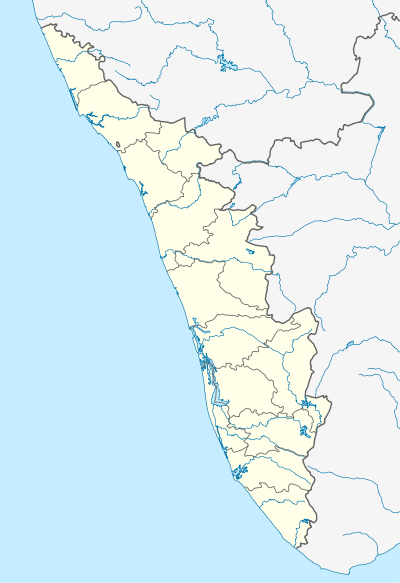Anamudi
| Anamudi | |
|---|---|
| Anai Mudi | |
 Landscape around Anamudi from Eravikulam National Park | |
| Highest point | |
| Elevation | 2,695 m (8,842 ft) [1][2] |
| Prominence | 2,479 m (8,133 ft) [3] |
| Listing |
Ultra List of Indian states and territories by highest point |
| Coordinates | 10°10′09″N 77°03′38″E / 10.16923°N 77.06066°ECoordinates: 10°10′09″N 77°03′38″E / 10.16923°N 77.06066°E [4] |
| Naming | |
| Translation | Elephant mountain (Tamil/Malayalam) |
| Geography | |
 Anamudi Location of Anamudi Peak in Kerala | |
| Location | Kerala, India |
| Parent range | Western Ghats |
| Geology | |
| Age of rock | Cenozoic (100 to 80 mya) |
| Mountain type | Fault-block |
| Climbing | |
| First ascent | General Douglas Hamilton |
| Easiest route | hike |
Anamudi or Anai Mudi[5] (Malayalam pronunciation: [aːnɐmʊɖi]) is located in the Indian state Kerala. It is the highest peak in the Western Ghats[6] and South India, at an elevation of 2,695 metres (8,842 ft),[1][2] and a topographic prominence of 2,479 metres (8,133 ft).[3] The name Anamudi literally translates to "elephant's forehead," a reference to the resemblance of the mountain to an elephant's head.[7]
The first recorded ascent of the Anamudi was by General Douglas Hamilton of the Madras Army on May 4, 1862, but it is likely that there had been earlier ascents by local people.
Climatic zones and biomes


Anamudi is the highest peak in the Western Ghats in India,[6] having an elevation of 2,695 metres (8,842 ft).[1][2][4] Anamudi is also the highest point in South India,[8] and also the highest point in India outside the Himalaya - Karakoram mountain range. This gives Anamudi its relatively large topographic prominence of 2,479 metres (8,133 ft), the associated key saddle being over 2,000 kilometres (1,200 mi) away at 28°35′20″N 76°27′59″E / 28.58889°N 76.46639°E in Haryana state just to the west of Delhi.[3] The peak is the highest point of the Periyar river basin.[9]
The peak is not exceptionally dramatic in term of steepness or local relief and is a Fault-block mountain.[10] It is located in the southern region of Eravikulam National Park at the junction of the Cardamom Hills, the Anaimalai Hills and the Palani Hills. The nearest town is Munnar, 13 kilometres (8.1 mi). The easiest route to the summit of Anamudi is a technically easy hike on grass slopes, starting from a rolling hill plateau with a base elevation of about 2,000 metres (6,600 ft). The north and south slopes are gentle, while the east and west slopes are steeper, with more difficult rock faces.
Anamudi and the Eravikulam National Park surrounding it is home to the largest surviving population of the Nilgiri tahr(Nilgiritragus hylocrius). Asian elephants, gaur, Bengal tigers, and the Nilgiri marten (Martes gwatkinsii) are some of the species of animals found here .[8] The Anamudi peak[11] area is also habitat of a unique frog Raorchestes resplendens.[12] This newly discovered species is located in the Eravikulam National Park and is restricted to less than three km2 on the summit of Anamudi.[13] The summit of the Anamudi is vegetated with patches of stunted Arundinaria densifolia and Gaultheria fragrantissima (wintergreen), Anaphalis sp., Impatiens and some species of Eriocaulon.[14]
See also
| Wikimedia Commons has media related to Anamudi. |
Citations
- 1 2 3 "Anamudi". Kerala Tourism. Retrieved 2014-11-26.
- 1 2 3 "Explore Wild Munnar". Eravikulam National Park. Retrieved 2014-11-26.
- 1 2 3 "Southern India Mountain Ultra-Prominence". Peaklist.org. Retrieved 2009-12-14.
- 1 2 "Anai Mudi, India". Peakbagger.com. Retrieved 2009-12-14.
- ↑ Anai Mudi (Approved - N) at GEOnet Names Server, United States National Geospatial-Intelligence Agency
- 1 2 "Anamudi - Kerala". Vedanta Wake up!. Retrieved 2014-11-26.
- ↑ The Imperial Gazetteer of India, v. 5 1909, p. 334
- 1 2 The Imperial Gazetteer of India, v. 12 1909, p. 220
- ↑ "Studies on the nature and chemistry of sediments and water of Periyar and Chalakudy Rivers, Kerala, India by Maya K." (PDF). Retrieved 2005-03-01.
- ↑ Hoiberg, Dale; Ramchandani, Indu (2000). Dale Hoiberg, ed. Students' Britannica India, Volumes 1-5. Popular Prakashan. p. 63. ISBN 0-85229-760-2.
- ↑ Anamudi peak
- ↑ "Significance of Eravikulam National Park". Eravikulam National Park. Retrieved 2014-11-26.
- ↑ "New species of frog found in Eravikulam National Park". The Hindu. Retrieved 2014-11-26.
- ↑ "Eravikulam National Park Management Plan". Eravikulam National Park. Retrieved 2009-12-14.
References
- Hunter, William Wilson (2009), The Imperial Gazetteer of India, BiblioBazaar, LLC, ISBN 1-110-35940-3.
- Hunter, William Wilson; James Sutherland Cotton; Richard Burn; William Stevenson Meyer; Great Britain India Office (1909). The Imperial Gazetteer of India 11. Clarendon Press. Archived from the original on 16 December 2008. Retrieved 2009-01-07.
External links
| ||||||||||||||||||||||||||||||||||||||||||
| ||||||||||||||||||||||||||||||||||||||||||||||||||||||||||||||||||||||||||||||||||